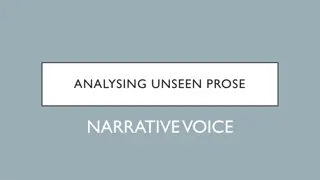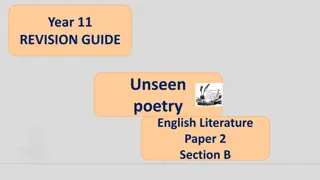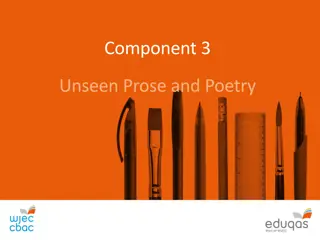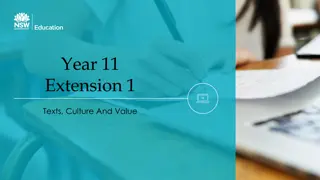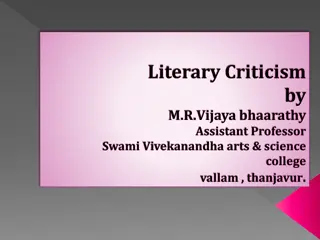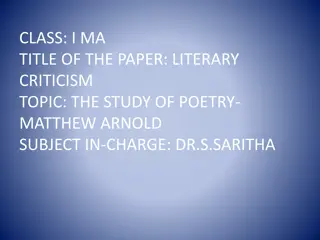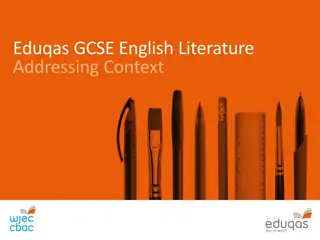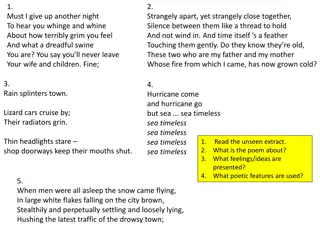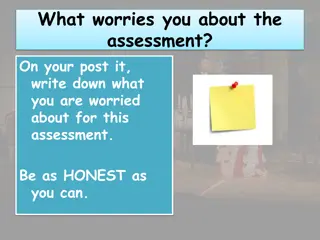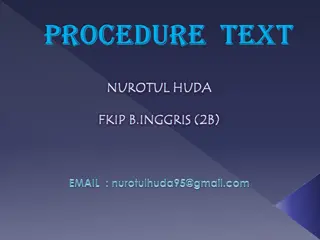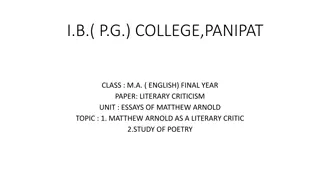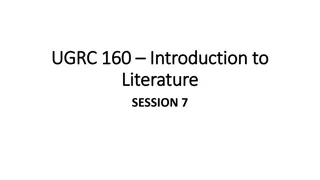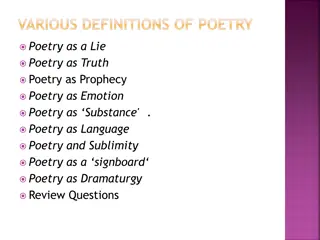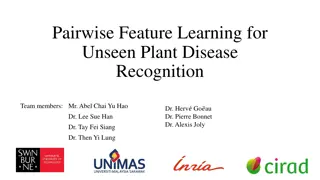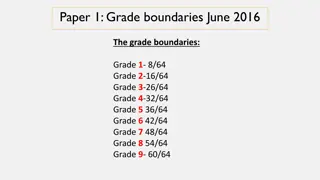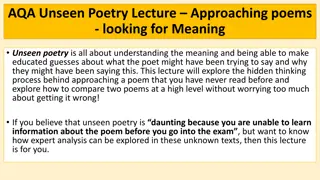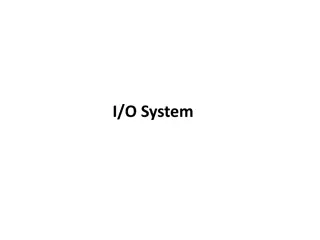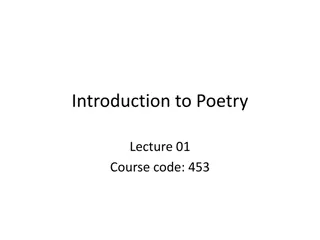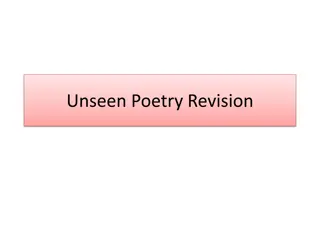Unseen Poetry Revision: Exploring Literary Texts, Devices, and Contexts
Delve into the world of unseen poetry revision by analyzing literary texts, exploring poetic devices, and understanding contextual factors associated with Victorian Literature. Engage in vocabulary challenges, pre-reading activities, and discussions to enhance your understanding of poetry. Enhance your analytical skills to compare the effects of language, structure, and form in poetry.
Download Presentation

Please find below an Image/Link to download the presentation.
The content on the website is provided AS IS for your information and personal use only. It may not be sold, licensed, or shared on other websites without obtaining consent from the author. Download presentation by click this link. If you encounter any issues during the download, it is possible that the publisher has removed the file from their server.
E N D
Presentation Transcript
Please have your planner open on todays date Planner Date: Monday, 08 June 2020 Title: Unseen Poetry Revision Copy Q1. What are the literature texts that you have studied? Q2. How many of the 15 Power and Conflict Poems can Do you remember? Q3. List 5 devices that you might look for in a poem. Q4. List 4 contextual factors associated with Victorian Literature.
Learning Focus: To revise unseen poetry. Learning Outcomes: Analyse the effect of language, structure and form Compare the effect of poetic methods
Engagement Look carefully at these Power & Conflict quotations. On a post-it-note can you write the poet s concept and message? Can you limit it to 50 words? Be prepared to share your answer.
Vocabulary Challenge Vocabulary Challenge heaviness What do these words mean? confined Which do you need to look up? perturbed Which do you need to log? despondent As you consider the poems today, think about which words are most appropriate. dissatisfied discontented
Pre-reading activity sick cotton Woman Work children to tend. rain cane shine on me call my own food
You now have 5 minutes to MAGPIE speak to your closest partner, sharing your ideas about what you predict the poem will be about. Please record your best findings in your English booklet. Mr Verity s tip: Speak to at least 2 other students in the class!
In the first poem, Woman Work, a black woman speaks about her life in the southern states of the USA. In the second poem, Overheard in County Sligo, a woman speaks about her life in Ireland. Woman Work Let s read Woman Work. I've got the children to tend The clothes to mend The floor to mop The food to shop Then the chicken to fry The baby to dry I got company to feed The garden to weed I've got shirts to press The tots to dress The cane to be cut I gotta clean up this hut Then see about the sick And the cotton to pick. Remember, you will get limited contextual detail in the real unseen exam. However, Maya Angelou is a fantastic writer and I want to share a few things about her. An acclaimed American poet, storyteller, activist, and auto biographer, Maya Angelou was born Marguerite Johnson in St. Louis, Missouri, USA. Angelou had a broad career as a singer, dancer, actress, composer, and Hollywood s first female black director, but became most famous as a writer, editor, essayist, playwright, and poet. As a civil rights activist, Angelou worked for Dr. Martin Luther King Jr. and Malcolm X. She was also an educator and served as the Reynolds professor of American Studies at Wake Forest University. Shine on me, sunshine Rain on me, rain Fall softly, dewdrops And cool my brow again. Storm, blow me from here With your fiercest wind Let me float across the sky 'Til I can rest again. Fall gently, snowflakes Cover me with white Cold icy kisses and Let me rest tonight. Sun, rain, curving sky Mountain, oceans, leaf and stone Star shine, moon glow You're all that I can call my own.
Read the poem for the first time. What is the general meaning? Let s annotate together Woman Work I've got the children to tend The clothes to mend The floor to mop The food to shop Then the chicken to fry The baby to dry I got company to feed The garden to weed I've got shirts to press The tots to dress The cane to be cut I gotta clean up this hut Then see about the sick And the cotton to pick.
Read the poem for the first time. What is the general meaning? Let s annotate together Shine on me, sunshine Rain on me, rain Fall softly, dewdrops And cool my brow again. Storm, blow me from here With your fiercest wind Let me float across the sky 'Til I can rest again.
Read the poem for the first time. What is the general meaning? Let s annotate together Fall gently, snowflakes Cover me with white Cold icy kisses and Let me rest tonight. Sun, rain, curving sky Mountain, oceans, leaf and stone Star shine, moon glow You're all that I can call my own.
Sun, rain, curving sky Mountain, oceans, leaf and stone Star shine, moon glow You're all that I can call my own. Why has Mr Verity chosen this quotation as being a key, important moment? Challenge: Can you explain what method the poet has used?
Now, re-read the poem slowly and carefully, highlighting and annotating as you go. Try and answer the following questions as you analyse the poem together: Deep read Deep read What is the poem s message and why did the poet write the poem? Who is speaking in the poem and how does the speaker feel? What is the tone of the poem? (mood) How does the poet make the reader feel? Which quotations help you understand the poem s message? (Highlight these) Can you identify any language or structural methods used by the poet? Which key words literally jump off the page because they give the reader important clues?
Think about the question. Read the poem for the second time. Begin to add to your annotations. How does the poet present the speaker s feelings about her life? You might start to pick out methods and layers of interpretation. What key language/ structural methods create impact? Think SMILE/METHODS. Does she use poetic devices like similes or metaphors to create images? Sensory language? Can you hear the sounds of words? Alliteration, assonance, sibilance? Lexical field of words? Structure like punctuation, line lengths, stanzas, sentence lengths etc. Tone of voice? Harsh or soft? Does it change?
Response 1 Response 2 The writer feels like she does not have a second to rest. The lack of punctuation throughout the first stanza, as she discusses all of her chores The floor to mop/ the food to shop creates a sense of breathlessness. The enjambment successfully highlights how the speaker of the poem is overworked and has to relentlessly complete many tasks. Additionally, the rhyming couplets create a song-like quality and effectively mirror the constant rhythm of the speaker s life and the fact that she has no time to stop. The way that the first stanza is structured effectively forces the reader to read the poem with pace; this allows the reader to empathise with the woman as they try to catch their breath. The writer uses lots of verbs in the first stanza. She talks about how she has to tend , mend , feed and weed . The verbs highlight how she is always doing something; she is never resting. Additionally, the verbs are definitely associated with jobs that are not necessarily enjoyable. They are jobs and chores that can be challenging. Annotate these responses. What is successful? What could be improved?
Over to you. TOP BAND CHECKLIST -Relate to the buzz words of the question throughout -Sophisticated style/ phrasing -Strong evidence (is it embedded?) -Identify techniques/ methods/ zoom in on key words -Layers of interpretation (explore the effect) this is effective because this successfully highlights this strongly asserts that this is particularly good at this makes the reader feel this creates a sense of -Writer s didactic purpose You have 30 minutes to write up your best three ideas. How does the poet present the speaker s feelings about her life?
TOP BAND CHECKLIST -Relate to the buzz words of the question throughout -Sophisticated style/ phrasing -Strong evidence (is it embedded?) -Identify techniques/ methods/ zoom in on key words -Layers of interpretation (explore the effect) this is effective because this successfully highlights this strongly asserts that this is particularly good at this makes the reader feel this creates a sense of -Writer s didactic purpose Purple pen work Use the criteria to annotate your response.
Comparing Unseen Poems. This is a short 8 mark question so it is important to: Make all your comments comparative Concentrate on the methods the two writers use Focus carefully on the question you re been asked. No matter how well you have structured your response, if you do not compare, you will get zero.
What is the question asking you to do? Comparing Read Overheard in County Sligo for the first time so you get a general meaning. In Woman Work , and Over heard in County Sligo , the speakers describe the lives they are living. What are the similarities and/or differences between the ways the poets describe their predicaments? Read it for the second time. Begin to identify 2/3 key things. Think about the Question. Think about the first poem, Woman Work , again. How are you going to make comparisons? Use a comparative statement/word to open your next paragraph then repeat the step above for the second poem linking it to the first. methods Write a balanced response.
Read the poem for the first time. What is the general meaning? Let s read poem two and annotate together The comparison bit Overheard in County Sligo I married a man from County Roscommon and I live in the back of beyond with a field of cows and a yard of hens and six white geese on the pond. At my door s a square of yellow corn caught up by its corners and shaken, and the road runs down through the open gate and freedom s there for the taking. I had thought to work on the Abbey stage or have my name in a book, to see my thought on the printed page, or still the crowd with a look.
Read the poem for the first time. What is the general meaning? Let s annotate together But I turn to fold the breakfast cloth and to polish the lustre and brass, to order and dust the tumbled rooms and find my face in the glass. I ought to feel I m a happy woman for I lie in the lap of the land, but I married the man from County Roscommon and I live at the back of beyond.
In Woman Work, and Over heard in County Sligo, the speakers describe the lives they are living. What are the similarities and/or differences between the ways the poets describe their predicaments? 1 2 In both Woman Work and Overheard in County Sligo the poets utilise structure to convey how the women are feeling. The BABA rhyming scheme mirrors the speakers monotonous life and how she feels trapped whereas in Woman Work the enjambment and rhyming couplets in the first stanza show how the woman does not have time to pause and rest. Annotate these responses. What is successful? What could be improved? In Woman Work the speaker finds salvation in the natural world towards the end of the poem when it says Fall softly, dewdrops/And cool my brow again. The writer presents the notion that nature has the power to create a sense of escapism and salvation for the woman. However, in Overheard in County Sligo the woman is surrounded by nature yet feels trapped in the back of beyond ; the speaker feels trapped in her predicament, living on a farm and her life isn t how she anticipated it would be.
Over to you. TOP BAND CHECKLIST -Relate to the buzz words of the question throughout -Comparative structure throughout -Compare the EFFECT of methods used -Sophisticated style/ phrasing -Strong evidence (is it embedded?) -Identify techniques/ methods/ zoom in on key words -Layers of interpretation (explore the effect) this is effective because this successfully highlights this strongly asserts that this is particularly good at this makes the reader feel this creates a sense of You have 30 minutes to write up your best three ideas. In Woman Work , and Over heard in County Sligo , the speakers describe the lives they are living. What are the similarities and/or differences between the ways the poets describe their predicaments?


